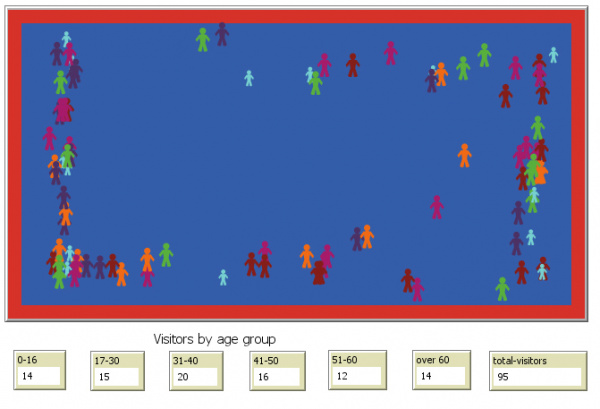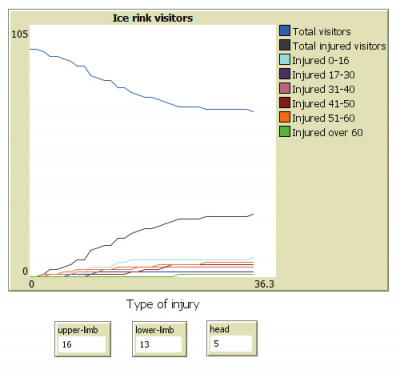Simulation of a public ice rink
Contents
Introduction
- Simulation topic: Simulation of a public ice skating rink
- Author: Marina Lushnikova
- Model type: Multiagent
- Modeling tool: NetLogo
Problem definition
With each winter season temporary ice skating rinks are seeing an increase in popularity. However, ice skating is also considered to be one of the sports with higher risk of accidents, where not only professional sportsmen but also recreational skaters can suffer from different kinds of injuries. The injuries can range from minor bruises to serious trauma. This can occur due to multiple reasons: inexperience, overcrowding, use of alcohol, and others. The simulation will show people of different age groups skating on the ice rink and illustrate how injuries may occur with certain probabilities based on real statistical data obtained from previous studies of the problem. The simulation will also be applied using parameters and current safety measures of the temporary ice rink on Letna.
Method
The method chosen for this simulation is multiagent simulation in Netlogo.
The goal of the simulation
The goal of the simulation is to find out how to make the whole ice skating experience safer, whether it be using some kinds of protective gear or improving other safety measures, and to illustrate what injuries are the most common and which age groups are at risk the most.
Model
Agents
Agents are represented by people visiting the ice rink. They are divided into six age groups. In the graphic interface these groups are represented by different colors. In addition, agents in the youngest age group are smaller in size.

GUI
Parameters
- Rink-length and Rink-width set up the dimensions of the ice rink. In order for the simulation to function correctly, the length number has to be larger than the width.
- People-on-ice sets up the number of visitors per session.
- Protective-gear-requirements – there are three options :
- none - no specific requirements
- helmets and gloves recommended
- full protective gear required, including lower limbs protection
- Restricted-capacity? some rinks restrict their capacity per square meter according to safety recommendation to prevent overcrowding
- Available-alcohol? at some rinks there is no restriction concerning alcohol consumption and drinks may be sold in the area of the facility.
- Setup clears previous parameters and sets up new parameters
- Go starts the simulation
Outputs

For this model there are several outputs. Firstly, there is a graph representing total numbers of visitors and injured visitors, then the injured visitors belonging to particular age groups. Secondly, there are types of injuries that may be sustained at the rink: these are divided into upper or lower limbs injuries, and head injuries.
Model limitations and assumptions
The studies previously conducted of the subject of injuries on the ice rinks usually study specific cases, so results of final probabilities may vary from study to study. Moreover, some parameters setup have not been analyzed yet, therefore in this model probabilities are based on broad assumptions. Another limitation is that the model simulates one skating session over an undefined period of time. For that reason injury probabilities were multiplied by ten in order to see some changes in the outputs.
Application of the model
Description
The goal is to apply the model using current safety measures in the temporary ice rink on Letna.
Data
Data concerning injury probabilities come from previous studies of injuries in the temporary ice rinks. [1] As for the ice rink on Letna, it was possible to gather the following information:
- Rink size is 40 by 20 meters [2]
- Number of visitors is based on the data from the webcam during different time frames. There was never over one hundred visitors. [3]
The other data were gathered on site.
- Protective gear – there is a requirement to use helmets and gloves, however, it is followed by only a small number of people, predominantly children. So we set this parameter on “helmets and gloves recommended”
- Capacity restriction – there is no restriction of capacity. However, the attendance is never as high as to threaten safety.
- Alcohol availability – hot wine and beer are sold in the area. However, stepping onto the ice rink under the influence of alcohol is forbidden.
Results

Let us set the parameters as above and conduct three iterations. In this case most injuries can happen to upper-limbs and the most endangered age group is 0-16.
| Iteration | Upper-limb | Lower-limb | Head injuries | Age group |
|---|---|---|---|---|
| 1. | 32 | 25 | 9 | 0-16 |
| 2. | 30 | 26 | 9 | 0-16 |
| 3. | 31 | 28 | 6 | 0-16 |
For the second example, let us change one parameter. As the capacity of the rink is not under threat, set the availability of alcohol to “on”. In this case the total number of injured has increased and the most endangered age group is 41-50.
| Iteration | Upper-limb | Lower-limb | Head injuries | Age group |
|---|---|---|---|---|
| 1. | 40 | 32 | 10 | 41-50 |
| 2. | 46 | 25 | 12 | 0-16 |
| 3. | 44 | 34 | 19 | 41-50 |
Thus we can conclude that in the case of this example, restriction of alcohol use on the ice rink is indeed an effective safety measure.
Conclusion
The model illustrated what injuries are the most common and what age group is most susceptive to injuries. However, this model is not useful for real safety measure analysis as it uses many unconfirmed assumptions, and even the data procured from statistical studies cannot be reliable for such specific cases. The model can be further developed and improved by adding more parameters, specifying how the potential injuries are distributed within separate age groups etc. In addition, this model lacks interaction between visitors, yet some percentage of injuries may happen due to collision with other skaters.
References
- ↑ BARR, Lynne V., Samirul IMAM, John R. CRAWFORD a P. Julian OWEN. Skating on thin ice: a study of the injuries sustained at a temporary ice skating rink. International Orthopaedics [online]. 2010, 34(5), 743-746 [cit. 2019-01-31]. DOI: 10.1007/s00264-010-0953-4. ISSN 0341-2695. Dostupné z: http://link.springer.com/10.1007/s00264-010-0953-4
- ↑ Veřejné bruslení [online]. [cit. 2019-01-31]. Dostupné z: https://verejne-brusleni.info/praha/kluziste-na-letne//>
- ↑ Ice-tec.cz [online]. [cit. 2019-01-31]. Dostupné z: http://ice-tec.cz/webcam/letna.html/>